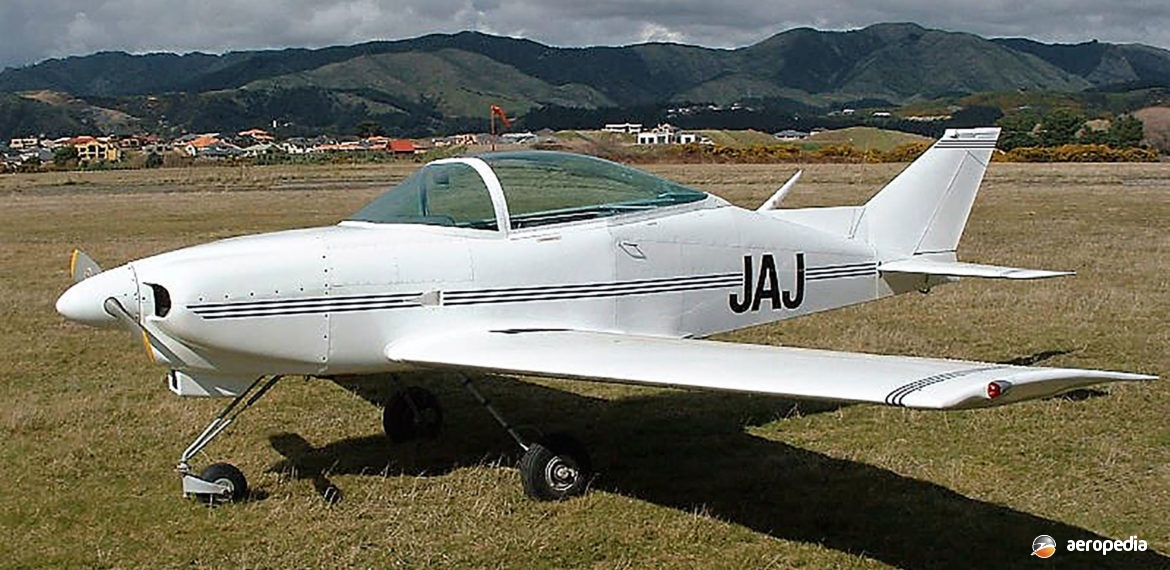Photograph:
Smyth Sidewinder ZK-JAJ (c/n AACA 287), which later became VH-DQW, at Paraparaumu, New Zealand in about 2001 (NZCIVAIR)
Country of origin:
United States of America
Description:
Two-seat light sport monoplane
Power Plant:
One 93 kw (125 hp) Avco Lycoming O-290 four-cylinder horizontally-opposed air-cooled engine
Specifications:
- Wingspan: 7.57 m (24 ft 10 in)
- Length: 5.89 m (19 ft 4 in)
- Height: 1.66 m (5 ft 5½ in)
- Wing area: 8.92 m² (96 sq ft)
- Max speed at 610 m (2,000 ft): 298 km/h (185 mph)
- Max cruising speed at 75% power at 610 m (2,000 ft): 257 km/h (160 mph)
- Max rate of climb at sea level: 366 m/min (1,200 ft/min)
- Stalling speed: 88 km/h (55 mph)
- Service ceiling: 4,570 m (15,000 ft)
- Range with max fuel and no reserves: 684 km (425 miles)
- Take-off run: 244 m (800 ft)
- Landing run: 366 m (1,200 ft)
- Empty weight: 393 kg (867 lb)
- Baggage allowance: 41 kg (90 lb)
History:
The design of the Sidewinder was commenced in 1958 by Jerry Smyth of Huntington, Indiana, it being a two-seat side-by-side sporting monoplane. It was usually fitted with a fixed tricycle undercarriage, was easy to build and fly, and was stressed to 9G for limited aerobatics. The prototype, powered by a 93 kw (125 hp) Lycoming O-290-G four-cylinder engine, made its first flight on 21 February 1969, and received the “Outstanding Design” award at the 1969 American Experimental Aircraft Association Fly-in at Oshkosh, Wisconsin. Plans subsequently became available for amateur constructors and, in order to simplify construction, components from other homebuilts could be used, such as the canopy from a Thorp T-18, and the undercarriage from a Wittman, etc.
Wings were all-metal with aluminium skin, and the steel-tube fuselage was also covered with aluminium skin. Engines ranging in power from 48 kw (65 hp) to 134 kw (180 hp) could be installed. A luggage compartment for 41 kg (90 lb) of baggage was standard. Only a couple of examples have been built in this region, the first completed in Australia being VH-KLV (c/n Q100) completed in 1995 at Palmwood, QLD, which later became VH-LKV. This aircraft was fitted with a retractable undercarriage and a 104 kw (140 hp) Lycoming O-290-D2B engine. Construction commenced in NSW before the builder moved to Queensland. During early testing it crashed on 7 January 1997 and was destroyed at Caboolture, QLD. At that time it was reported to be carrying out circuits but did not have a Certificate of Airworthiness or a Permit to Fly.
Construction of another Sidewinder was commenced by Mr J Cooper of Wollongong, NSW, the registration VH-MUO being allotted but it is not known to have been completed and flown and no airframe number seems to have been allotted.
First in New Zealand was Model S ZK-JAJ (c/n AACA/680) registered in February 1986 in Wellington, followed by a Model 2 ZK-DYY (c/n AACA 184) in Napier. The latter aircraft was lost when, on 25 November 2006, it took off from a beach at North Head at Kaipara Harbour and crashed into the sea.
Further examples were completed in Australia, including in May 2011 VH-DQW (c/n 287) to its owner at Beachmore, QLD. This aircraft was ZK-JAJ (c/n AACA-287 – ex ZK-JAJ, [ZK-JIM], [ZK-DYZ]) in New Zealand initially. Further examples became VH-FYP (c/n QC-007) registered on 22 May 2001, based in Canberra, ACT and withdrawn from service on 14 November 2005.
A further Sidewinder became ZK-CXJ (c/n NZS1) built by William Ryan at Invercargill and registered on 25 July 2005. Fitted with a Leyland P-76 alloy V-8 engine it was first flown on 2 November 2007. Another aircraft was imported to New Zealand and has operated with its American registration, N50VL.

